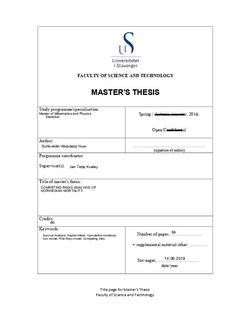Competing risk analysis of Norwegian mortality
Master thesis
Permanent lenke
http://hdl.handle.net/11250/2623878Utgivelsesdato
2019-06Metadata
Vis full innførselSamlinger
- Studentoppgaver (TN-IMF) [104]
Sammendrag
Survival data analysis is a set of statistical methodologies that is used to model time until a certain event occurs. Competing risks data arise frequently in survival data from medical research in situations when individuals under study are exposed to more than one type of event such as death from different causes, and occurrence of one of these events prevent the occurrence of the event of interest. This thesis introduces the conventional methods of survival analysis such as Kaplan-Meier and Cox proportional model, and methods which are used in presence of competing risks such as cumulative incidence and Fine-Gray model. The Norwegian mortality data in three countries where individuals were at risk to death from four death causes was used in this thesis to make comparisons between estimates of Kaplan-Meier and cumulative incidence and between the hazard rates estimated by Cox model and Fine-Gray model. The low rate of overall death in the data of Norwegian mortality in three counties resulted in very small differences between the estimates of survival probabilities of Kaplan-Meier and cumulative incidence, and between hazard rates estimated by Cox model and Fine-Gray model, but there are some differences between the two models in estimating the impact of some covariates.
Beskrivelse
Master's thesis in Mathematics and physics
